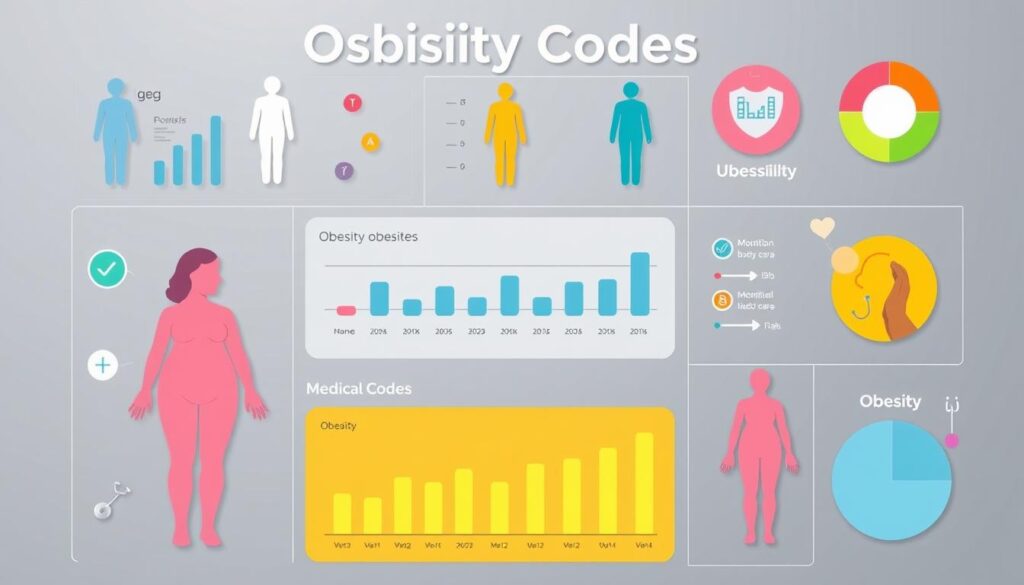Understanding obesity diagnosis codes can be hard for healthcare providers. But, with the right tools, you can learn the ICD-10-CM system well. This guide will help you know how to code for obesity right. It will also help you get the right payment for your work. You’ll learn how to give the best care to your patients with obesity diagnosis coding.
Key Takeaways
- Understand the structure and subcategories of the ICD-10-CM E66 code series for overweight and obesity
- Familiarize yourself with the primary categories of obesity coding, including severity-based classifications
- Learn about the importance of accurate obesity coding in improving diagnostic accuracy, data reporting, and patient care
- Discover the role of BMI Z-codes in documenting obesity status for both adult and pediatric patients
- Explore coding guidelines for morbid obesity and obesity-related complications and comorbidities
Understanding Obesity ICD 10 Codes and Classifications
Understanding obesity diagnosis and coding can be hard. But knowing the ICD-10 system is key for right medical records and payment. The E66 code series in ICD-10-CM helps classify obesity types, from morbid to overweight.
Basic Structure of E66 Code Series
The E66 code series has subcategories from E66.0 to E66.9. Each code shows a different type of obesity. These include obesity due to excess calories, drug-induced obesity, morbid obesity, and overweight. It’s important to use these codes right for billing, records, and treatment.
Primary Categories of Obesity Coding
Here are the main obesity coding categories in the E66 series:
- E66.01: Morbid (severe) obesity due to excess calories
- E66.1: Drug-induced obesity
- E66.2: Morbid (severe) obesity with alveolar hypoventilation
- E66.8: Other obesity
- E66.9: Obesity, unspecified
Importance of Accurate Classification
Accurate obesity classification is very important. It helps with billing and records. It also lets doctors plan better treatments. Using BMI and obesity complication codes gives a full health picture.
“Accurate coding of obesity is essential for proper medical billing, comprehensive documentation, and effective treatment planning.”
Common Obesity ICD-10 Codes for Clinical Practice
Using the right ICD-10 codes for obesity is key for good medical records and getting paid. The main obesity ICD-10 codes are:
- E66.01 Morbid (severe) obesity due to excess calories
- E66.09 Other obesity due to excess calories
- E66.1 Drug-induced obesity
- E66.2 Morbid (severe) obesity with alveolar hypoventilation
- E66.3 Overweight
- E66.9 Obesity, unspecified
These codes help doctors and hospitals document and bill for obesity care. It’s important to pick the right obesity ICD-10 codes, obesity diagnosis codes, and overweight classification codes. This ensures you get paid right and follow coding rules.
The U.S. Department of Health and Human Services says 5.5 percent of men and 9.9 percent of women are very obese. More than 70 percent of Americans are overweight or obese, says the American Heart Association/American College of Cardiology.
The ICD-10 code for obesity is E66. It has more codes that give details on why someone is obese. Doctors need to use these codes right to manage and document obesity in their patients.
BMI Z-Codes and Their Role in Obesity Documentation
It’s very important to document a patient’s body mass index (BMI) correctly. BMI Z-codes help explain a patient’s BMI status. They give more information that helps doctors make better choices and get the right payment.
Adult BMI Classification Codes
Adults with a BMI of 30.0 to 39.9 use code Z68.3X. If their BMI is 40.0 or higher, codes range from Z68.41 to Z68.45. Using these Z-codes helps document how severe a patient’s obesity is.
Pediatric BMI Coding Guidelines
Pediatric patients aged 2 to 19 use BMI percentiles instead of numbers. Code Z68.53 is for a BMI between the 85th and less than the 95th percentile. Code Z68.54 is for a BMI of 95th percentile or higher.
Special Considerations for BMI Documentation
It’s important to record a patient’s BMI at every visit. This is because the Z-code might change, even if the main obesity diagnosis doesn’t. Also, BMI Z-codes shouldn’t be used for pregnant women, as their weight can change during pregnancy.
Creating rules for BMI documentation in your facility is key. This ensures accurate code use and meets reportable diagnosis standards. Consider when the BMI was measured and if weight was discussed during the stay.
| BMI Classification | Adult BMI Z-Code | Pediatric BMI Z-Code |
|---|---|---|
| Underweight | Z68.1 (BMI less than 18.5) | Z68.51 (BMI less than 5th percentile) |
| Healthy Weight | Z68.20-Z68.24 (BMI 18.5-24.9) | Z68.52 (BMI 5th percentile to less than 85th percentile) |
| Overweight | Z68.25-Z68.29 (BMI 25.0-29.9) | Z68.53 (BMI 85th percentile to less than 95th percentile) |
| Obesity | Z68.3X (BMI 30.0-39.9), Z68.41-Z68.45 (BMI ≥40.0) | Z68.54 (BMI greater than or equal to 95th percentile) |
Understanding BMI Z-codes helps healthcare providers document obesity well. This supports accurate coding and payment. It also helps give better care to patients.
Morbid Obesity Coding Guidelines and Specifications
Healthcare providers must follow specific guidelines when coding for morbid obesity. This includes using the right ICD-10 codes. Morbid obesity is when a person’s Body Mass Index (BMI) is 40 or higher.
The main codes for morbid obesity are E66.01 (morbid obesity due to excess calories) and E66.2 (morbid obesity with alveolar hypoventilation).
It’s important to pair these codes with BMI Z-codes. These codes show how severe the obesity is. They range from Z68.41 (BMI 40.0-44.9, adult) to Z68.45 (BMI 60.0 and over, adult).
Statistics show that 5.5 percent of men and 9.9 percent of women in the United States are morbidly obese. More than 70 percent of Americans are overweight, obese, or morbidly obese. Accurate coding is key for proper care and payment.
Healthcare professionals should follow these best practices when coding for morbid obesity:
- Choose the right morbid obesity code (E66.01 or E66.2) for the patient’s condition.
- Use the matching BMI Z-code to give a full picture of the patient’s health.
- Make sure the BMI matches the BMI Z-code for accurate payment and reporting.
- Keep up with the latest coding rules to stay compliant and get the most reimbursement.
By following these guidelines, healthcare providers can better care for patients. They can also get the right payment and help fight the obesity problem in the United States.
Coding for Obesity-Related Complications and Comorbidities
When coding for patients with obesity, it’s key to capture all their health issues. Obesity often comes with diabetes, heart problems, and breathing issues. Accurate coding helps in treating patients right, getting the right money back, and caring for them better.
Diabetes and Obesity Coding
For those with obesity and diabetes, list the obesity code (E66.XX) first. Then, use the right code for diabetes type (E11.XX for type 2). This shows obesity’s big role in diabetes.
Cardiovascular Complications
Obesity greatly increases the risk of heart diseases. Use the obesity code with heart disease codes like hypertension (I10). This shows obesity’s link to heart health.
Respiratory Conditions
Obesity can cause breathing problems like sleep apnea (G47.3X). List obesity first, then the breathing issue code. This ensures all obesity-related breathing problems are noted and treated.
By following these guidelines, healthcare providers can show all obesity-related health issues in medical records. This helps in better treatment, management, and research into comorbidities of obesity and obesity-related complications.
“Proper coding for obesity-related conditions is crucial for ensuring accurate documentation, appropriate reimbursement, and effective treatment of these complex, multifaceted health issues.”
Documentation Requirements for Obesity Claims
When filing claims for obesity-related services, proper documentation is key. Healthcare providers must record important details in the patient’s medical record. This includes the patient’s body mass index (BMI) at each visit.
They should also note any changes in weight or BMI. And they must capture the obesity-related complications treated during the visit.
It’s also important to document information that supports the use of specific obesity diagnosis codes (like E66.0, E66.1, E66.2, E66.3, E66.8, and E66.9). And BMI Z-codes (Z68.XX) for accurate billing. Providers should detail the treatment plan, any lifestyle interventions or counseling given, and the patient’s progress.
- Accurately document the patient’s BMI at every visit, using the right Z-codes (Z68.XX) to show the classification.
- Record any changes in the patient’s weight or BMI over time, and the obesity-related complications treated during the visit.
- Make sure the documented info supports the use of specific obesity diagnosis codes (E66.X) and the right CPT/HCPCS-II codes for counseling and risk factor reduction (99401-99404, 99411-99412).
- Give details on the treatment plan, lifestyle interventions, and counseling given to the patient. Show how you’re tackling obesity comprehensively.
By carefully recording all important info in the patient’s medical record, healthcare providers can ensure accurate coding. This leads to smooth billing and proper reimbursement for obesity diagnosis codes, obesity treatment guidelines, and obesity prevention strategies.

“Proper documentation is the key to successful obesity management and reimbursement. Attention to detail can make all the difference in supporting your claims.”
Proper Use of Additional Codes and Modifiers
When dealing with obesity, using the right codes and modifiers is key. It helps with accurate reports and better payments. Knowing the rules can really help.
Modifier Guidelines
Modifier 25 is important for billing when you see a patient for both counseling and a medical visit on the same day. It lets you get paid for both services. Use Modifier 33 for preventive services like obesity checks and counseling. This way, these services don’t cost extra.
Secondary Diagnosis Codes
Secondary codes are important for showing related health issues. For example, type 2 diabetes, cardiovascular disease, and respiratory disorders need their own codes. Use Z71.3 for diet advice and Z71.82 for exercise tips.
Always check your patient’s insurance plan before using extra codes and modifiers. Keeping up with coding rules helps you get paid right for your work.
| Modifier | Description | Example Usage |
|---|---|---|
| 25 | Significant, Separately Identifiable Evaluation and Management Service by the Same Physician or Other Qualified Health Care Professional on the Same Day of the Procedure or Other Service | Reporting a distinct E/M service on the same day as obesity counseling |
| 33 | Preventive Service | Identifying obesity screening or behavioral intervention as a preventive service |
Billing and Reimbursement Considerations
Managing obesity means knowing how to bill and get paid. Healthcare providers face a tough world of obesity treatment guidelines, obesity prevention strategies, and obesity diagnosis codes. They must document and submit claims correctly.
For obesity management visits, use codes like 99213 for a 15-minute session with a known patient. For lifestyle therapy, use codes 99401-99404 for one-on-one counseling or 99411-99412 for group sessions.
Make sure to add the right ICD-10 codes, BMI Z-codes, and modifiers. This shows why the services are needed. Check with insurance or state Medicare/Medicaid to bill right and get paid on time.
| Code Type | Description | Reimbursement Considerations |
|---|---|---|
| Evaluation and Management (E/M) | 99213 for 15-minute appointment with established patient | Use appropriate E/M codes based on time and complexity of the visit |
| Preventive Medicine Counseling | 99401-99404 for individual counseling, 99411-99412 for group counseling | Bill based on the time spent providing counseling and education |
| HCPCS Codes | G0447 for 15-minute face-to-face behavioral counseling, G0473 for 30-minute group counseling | CMS-recognized codes for obesity screening and counseling |
Healthcare providers can improve billing and get more services for obesity by knowing the latest obesity treatment guidelines, obesity prevention strategies, and obesity diagnosis codes.

Special Coding Scenarios in Obesity Management
Healthcare providers often face unique challenges when coding for obesity. This includes obesity during pregnancy and in children. Knowing the right codes is key for correct billing and care.
Pregnancy and Obesity Coding
For obesity during pregnancy, use O99.21- first. Then add the obesity code from the E66.- series. This way, both the pregnancy issue and obesity are documented well.
Pediatric Obesity Considerations
Coding for kids with obesity is different from adults. Use the E66.0X series for pediatric obesity. These codes depend on the child’s age and BMI.
Also, think about any extra health issues. For example, Prader-Willi syndrome (Q87.11) can affect weight.
When coding for childhood obesity, use the right childhood obesity codes and BMI Z-codes. This helps in following obesity treatment guidelines and getting the right care.
“Addressing obesity, especially in children, requires a multifaceted approach that combines medical intervention, lifestyle modifications, and community-based support. Accurate coding is a critical first step in providing the necessary care and resources for patients struggling with this complex condition.”
Common Coding Errors and How to Avoid Them
Accurate medical coding is key for managing obesity well. But, mistakes can cause problems like claim denials and less money for care. As obesity rates grow, it’s vital for doctors to know common coding errors and how to fix them.
One big mistake is using old obesity ICD-10 codes. The E66 codes change often. It’s important to know these changes to code right. Another error is not using BMI Z-codes, which help show a patient’s health.
Not writing down obesity-related problems and other health issues is another mistake. Conditions like diabetes and sleep apnea often go with obesity. It’s important to record these to get the right care and money for treatment.
- Regularly update your knowledge of obesity ICD-10 codes and revisions
- Carefully review documentation before coding to ensure all relevant information is captured
- Double-check the accuracy of BMI calculations and their corresponding Z-codes
- Be cautious when coding for pregnant patients with obesity, as BMI Z-codes should not be used in these cases
By being careful and following best practices, doctors can avoid common coding mistakes. This ensures accurate reporting, right payment, and better care for people with obesity.
| Common Coding Errors | Tips to Avoid Errors |
|---|---|
| Using outdated obesity ICD-10 codes | Regularly update coding knowledge |
| Failing to include BMI Z-codes | Carefully review documentation before coding |
| Not documenting obesity-related complications | Ensure all relevant information is captured |
| Coding errors for pregnant patients with obesity | Avoid using BMI Z-codes for pregnant patients |
By fixing these common coding mistakes and following best practices, doctors can make obesity ICD-10 coding more accurate. This improves patient care and helps get the right money for obesity services.
Conclusion
Accurate obesity coding is key for good patient care and billing. Keeping up with obesity ICD 10 codes is important. It helps your practice give the best care to patients with weight issues.
Regularly check your coding to follow obesity treatment guidelines. This keeps your practice in line and helps patients get better.
Remember, the ICD-10-CM code E66.3 is for overweight, not obesity. Make sure to use the right codes for each condition. This helps with patient care and getting paid for services.
Don’t make common mistakes like coding obese patients wrong. Always document how obesity affects patient care.
By keeping up with coding, you help patients get better and get paid right. Use tools like ICD-10 guidelines and Tebra’s EHR+ system. They make your work easier and help you use obesity diagnosis codes right.


A Life-Changing Experience with This Weight Loss Supplement (Nagano Tonic)
I’ve always struggled with finding a weight loss solution that actually works for me. Like many, I’ve tried numerous diets, exercise routines, and supplements over the years—some worked for a short time, but nothing ever gave me long-term results. That was until I decided to try the weight loss supplement I found : Link to the Supplement.
From the moment I started using it, I noticed a difference. Not only did I feel more energized, but my cravings also became more manageable. The best part? I started seeing results much quicker than I anticipated! Over the course of just a few weeks, I noticed a significant reduction in belly fat and overall weight loss that I hadn’t been able to achieve before.
What makes this supplement stand out from all the others I’ve tried is how it supports me in my daily routine without any jitters or energy crashes. I’m able to stay focused and motivated, which has made it easier to stay on track with my diet and exercise plan.
This product truly exceeded my expectations, and I feel more confident and healthier than ever before. If you’re struggling with your weight loss journey like I was, I highly recommend giving this supplement a try. It’s been a game-changer for me, and I’m sure it can work wonders for you too!
Contant Them on email .. tonicnagano50@gmail.com
wasn’t sure what to expect, but this weight loss supplement has really impressed me! After just a few weeks of use, I’ve already dropped a few pounds and feel more motivated to stay active. It’s helped curb my cravings and boosted my energy throughout the day. I’m excited to keep going and see even better results. Definitely worth trying!
Reach them on tonicnagano50@gmail.com
I’ve tried so many weight loss products, but this one has been by far the most effective. In just a few weeks, I’ve noticed a visible difference in my body and energy levels. It’s helped me stay on track without the constant hunger pangs and cravings. I’m really happy with my progress and can’t wait to see where I’ll be in another month!
I’ve tried so many weight loss products over the years, but nothing worked like this supplement! Since I started using it, I’ve noticed a big difference in my energy levels and appetite control. In just a few weeks, I’ve lost weight and feel so much better. It’s been easy to stick with, and the results speak for themselves. Highly recommend this to anyone looking to make a real change!
This Nagano Tonic has been amazing! In just a few weeks, I’ve lost weight, feel more energized, and my cravings are under control. Highly recommend it!
Thats the link to purchase http://surl.li/iasppy